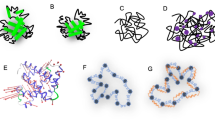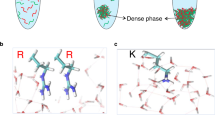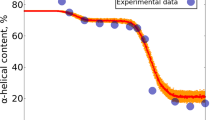Abstract
The ensemble of forces that stabilize protein structure and facilitate biological function are intimately linked with the ubiquitous aqueous environment of living systems. As a consequence, biomolecular activity is highly sensitive to the interplay of solvent–protein interactions, and deviation from the native conditions, for example by exposure to increased thermal energy or severe dehydration, results in denaturation and subsequent loss of function. Although certain enzymes can be extracted into non-aqueous solvents without significant loss of activity, there are no known examples of solvent-less (molten) liquids of functional metalloproteins. Here we describe the synthesis and properties of room-temperature solvent-free myoglobin liquids with near-native structure and reversible dioxygen binding ability equivalent to the haem protein under physiological conditions. The realization of room-temperature solvent-free myoglobin liquids with retained function presents novel challenges to existing theories on the role of solvent molecules in structural biology, and should offer new opportunities in protein-based nanoscience and bionanotechnology.
This is a preview of subscription content, access via your institution
Access options
Subscribe to this journal
Receive 12 print issues and online access
$259.00 per year
only $21.58 per issue
Buy this article
- Purchase on Springer Link
- Instant access to full article PDF
Prices may be subject to local taxes which are calculated during checkout



Similar content being viewed by others
References
Rariy, R. V. & Klibanov, A. M. Correct protein folding in glycerol. Proc. Natl Acad. Sci. USA 94, 13520–13523 (1997).
Knubovets, T., Osterhout, J. J., Connolly, P. J. & Klibanov, A. M. Structure, thermostability, and conformational flexibility of hen egg-white lysozyme dissolved in glycerol. Proc. Natl Acad. Sci. USA 96, 1262–1267 (1999).
Clark, D. S. Characteristics of nearly dry enzymes in organic solvents: implications for biocatalysis in the absence of water. Phil. Trans. R. Soc. Lond. B 359, 1299–1307 (2004).
van Rantwijk, F. & Sheldon, R. A. Biocatalysis in ionic liquids. Chem. Rev. 107, 2757–2785 (2007).
Kikkawa, S., Takahashi, K., Katada, T. & Inada, Y. Esterification of chiral secondary alcohols with fatty-acid in organic-solvents by polyethylene glycol-modified lipase. Biochem. Int. 19, 1125–1131 (1989).
Kodera, Y., Nishimura, H., Matsushima, A., Hiroto, M. & Inada, Y. Lipase made active in hydrophobic media by coupling with polyethylene-glycol. J. Am. Oil Chem. Soc. 71, 335–338 (1994).
Basri, M. et al. Synthesis of fatty esters by polyethylene glycol-modified lipase. J. Chem. Technol. Biot. 64, 10–16 (1995).
Okahata, Y. & Ijiro, K. A lipid-coated lipase as a new catalyst for triglyceride synthesis in organic solvents. Chem. Commun. 1392–1394 (1988).
Okahata, Y. & Ijiro, K. Preparation of a lipid-coated lipase and catalysis of glyceride ester syntheses in homogeneous organic solvents. Bull. Chem. Soc. Jpn 65, 2411–2420 (1992).
Mattos, C. & Ringe, D. Proteins in organic solvents. Curr. Opin. Struct. Biol. 11, 761–764 (2001).
Liu, L., Bagal, D., Kitova, E. N., Schnier, P. D. & Klassen, J. S. Hydrophobic protein–ligand interactions preserved in the gas phase. J. Am. Chem. Soc. 131, 15980–15981 (2009).
Perriman, A. W., Colfen, H., Hughes, R. W., Barrie, C. L. & Mann, S. Solvent-free protein liquids and liquid crystals. Angew. Chem. Int. Ed. 48, 6242–6246 (2009).
Lin, Y. et al. Self-directed self-assembly of nanoparticle/copolymer mixtures. Nature 434, 55–59 (2005).
Wong, K. K. W. & Mann, S. Biomimetic synthesis of cadmium sulphide–ferritin nanocomposites. Adv. Mater. 8, 928–932 (1996).
Costantino, H. R., Curley, J. G. & Hsu, C. C. Determining the water sorption monolayer of lyophilized pharmaceutical proteins. J. Pharm. Sci. 82, 1390–1393 (1997).
Pauling, L. The adsorption of water by proteins. J. Am. Chem. Soc. 67, 555–557 (1945)
Goormaghtigh, E., Ruysschaert, J. M. & Raussens, V. Evaluation of the information content in infrared spectra for protein secondary structure determination. Biophys. J. 90, 2946–2957 (2006).
Ishida, K. P. & Griffiths, P. R. Comparison of the amide-I/II intensity ratio of solution and solid-state proteins sampled by transmission, attenuated total reflectance, and diffuse reflectance spectrometry. Appl. Spectrosc. 47, 584–589 (1993).
Pelton, J. T. & McLean, L. R. Spectroscopic methods for analysis of protein secondary structure. Anal. Biochem. 277, 167–176 (2000).
Li, Q. C. & Mabrouk, P. A. Spectroscopic and electrochemical studies of horse myoglobin in dimethyl sulfoxide. Phil. Trans. R. Soc. Lond. B 8, 83–94 (2003).
Ikedasaito, M. et al. Coordination structure of the ferric heme iron in engineered distal histidine myoglobin mutants. J. Biol. Chem. 267, 22843–22852 (1992).
Antonini, E. & Brunori, M. Hemoglobin and myoglobin in their reactions with ligands (eds Neuberger, A. & Tatum, E. L.) (North Holland Publishing Company, 1971).
Schenkman, K. A., Marble, D. R., Burns, D. H. & Feigl, E. O. Myoglobin oxygen dissociation by multiwavelength spectroscopy. J. Appl. Physiol. 82, 86–92 (1997).
Andersen, K. K., Westh, P. & Otzen, D. E. Global study of myoglobin–surfactant interactions. Langmuir 24, 399–407 (2008).
Andersen, K. K. et al. The role of decorated SDS micelles in sub-CMC protein denaturation and association. J. Mol. Biol. 391, 207–226 (2009).
Lee, H., de Vries, A. H., Marrink, S. J. & Pastor, R. W. A coarse-grained model for polyethylene oxide and polyethylene glycol: conformation and hydrodynamics. J. Phys. Chem. B 113, 13186–13194 (2009).
Acknowledgements
We thank EPSRC (Platform grant no. EP/C518748/1) for financial support, A. Völkel for performing the analytical ultracentrifugation experiments, and J. Lewis for performing the high-speed macro photography.
Author information
Authors and Affiliations
Contributions
S.M. and A.W.P. contributed to the project's inception. A.P.S.B. and A.W.P. designed the experiments and performed the synthesis. H.C. performed the analysis on the analytical ultracentrifugation results, N.T., G.R.O., A.P.S.B. and A.W.P. conducted the ligand binding studies, and S.M. and A.W.P. wrote the paper. All authors discussed the results and commented on the manuscript.
Corresponding author
Ethics declarations
Competing interests
The authors declare no competing financial interests.
Supplementary information
Supplementary information
Supplementary information (PDF 4819 kb)
Rights and permissions
About this article
Cite this article
Perriman, A., Brogan, A., Cölfen, H. et al. Reversible dioxygen binding in solvent-free liquid myoglobin. Nature Chem 2, 622–626 (2010). https://doi.org/10.1038/nchem.700
Received:
Accepted:
Published:
Issue Date:
DOI: https://doi.org/10.1038/nchem.700
This article is cited by
-
Creation of stable water-free antibody based protein liquids
Communications Materials (2021)
-
Artificial cell membrane binding thrombin constructs drive in situ fibrin hydrogel formation
Nature Communications (2019)
-
Non-aqueous homogenous biocatalytic conversion of polysaccharides in ionic liquids using chemically modified glucosidase
Nature Chemistry (2018)
-
Insight into the molecular mechanism behind PEG-mediated stabilization of biofluid lipases
Scientific Reports (2018)
-
A Guide to Design Functional Molecular Liquids with Tailorable Properties using Pyrene-Fluorescence as a Probe
Scientific Reports (2017)



